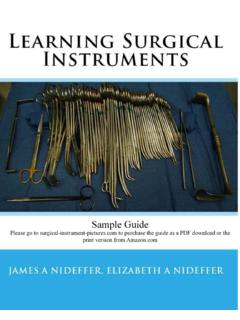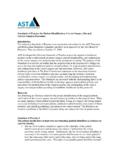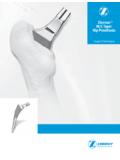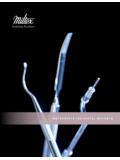Transcription of SPD Level I Training Manual - Section VI
1 surgical instrumentation [This page intentionally left blank.] 129 surgical instrumentation Instrument Assembly and Preparation 130 [This page intentionally left blank.] 131 OBJECTIVES Following Training , employees will be able to: 1. Recognize the common use instrumentation . 2. Identify instruments for different types of surgical uses. 3. Identify the different parts of instruments. 4. Distinguish the difference between hand-held and powered instruments and flexible and rigid endoscopes. 5. Explain the proper placement of instruments into trays, sets, and containers. 6. Understand the proper stringing of string instruments and how to place instruments on the stringer to assure easy access. 7. Demonstrate testing procedures for all instruments and identify malfunctions.
2 8. Define the different care and handling aspects for surgical instruments. 9. Discuss recommended processing procedures for all surgical instruments. 10 Demonstrate the proper placement of instrument trays and sets on the sterilization carts. 11. Know the correct storage and transportation for both soiled and sterile instrument sets and trays. 12. Explain the difference between floor grade and surgical grade instruments. 132 [This page intentionally left blank.] 133 surgical instrumentation 1. INTRODUCTION a. As surgical technology continues to advance, so does the type and complexity of surgical instrumentation . surgical instruments are a major investment in the hospital setting and require special care and handling to maintain proper function and longevity. This is dependent solely on how an instrument is used and cared for.
3 The operating room staff, as well as the SPD technicians, are required to use, assemble, and recognize thousands of different types of surgical instruments and devices. b. Not all facilities are involved in cleaning and sterilization of surgical instrumentation . However, they may be required to assemble special procedure trays for clinics, dental, and special use areas. These areas may utilize surgical grade instruments, versus the ward or floor grade instruments, with the different types of surgical instruments available. Regardless of the type of support offered a medical facility, the SPD technician should be familiar with the different types of surgical instruments in the event the facility decides to include SPD in the care, handling, and assembly of surgical instrumentation . c. SPD is responsible for inspecting the instruments prior to sterilization to assure the instruments have been cleaned properly, tested, and checked for proper function and damage (cracked box locks, etc.)
4 , and assembled according to an accurate and detailed procedure list, agreed upon by the operating room. A damaged instrument should be sent for repair and a replacement placed in the set. d. Instruments are divided into several classifications: (1) Hand held, which consist of general use, microsurgical, and laser. (2) Flexible and rigid endoscopes that require light carriers and fiberoptic cords, fiberoptic rigid telescopes used with bridges, sheaths, and obturators. (3) Powered equipment which can be electrical, pneumatic, or battery operated. 2. HAND HELD surgical INSTRUMENTS a. Hand held are the most common type of surgical instrumentation . Once the general, most common types of instruments are identified, the technician will be able to recognize them regardless of the different patterns, designs, and sizes utilized for specific surgeries.
5 For example, tissue forceps used in eye surgery will resemble tissue forceps used in general surgery, the only difference being the size. The same holds 134 true for retractors, needle holders, etc. The exception to this would be the specialized instruments used for orthopedic and dental procedures. b. The basic uses for these instruments fall into the following categories: (1) Hemostatic Forceps. These forceps can be called clamps, artery forceps, and hemostats. The main purpose of hemostats is to achieve hemostatis (control of blood flow in the vessel). Most hemostats are available in different lengths, curved and straight, with serrated jaws. Some also have toothed ends. Examples of hemostats: Mosquito, Kelly, Carmalt, Schnidt tonsil, and Kocher. Hemostatic Forceps (A) Mosquite, (B) Kelly, (C) Kocher, (D) Carmalt, (E) Schnidt Tonsil (2) Soft Tissue Forceps.
6 Similar to hemostats, these forceps are used for holding and retracting soft tissue for longer periods. Characteristics include fine teeth or ridges on the jaws to provide a more delicate grip without trauma to tissue. They also consist of ring handles and box locks, as do the hemostatic forceps. Examples are: Backhaus Towel, Allis Intestinal, Babcock Intestinal, Kocher Artery, Mixter Gall Duct, Kantorwitz Right Angle, and Forester sponge forceps. (3) Other Soft Tissue Forceps (Thumb). Thumb forceps do not have box locks or ring handles but rather have spring handles which are held closed by the 135 Soft Tissue Forceps (A) Backhaus Towel, (B) Allis Intestinal, (C) Babcock Intestinal, (D) Lahey Goiter, (E) Mixter Gall Duct, (F) Doyen Intestinal, (G) Forrester Sponge, (H) Kantorwitz Right Angle, and (I) NonperforatingTowel Clamp Thumb Forceps (A) Adson, (B) Brown-Adson, (C) Thumb w/teeth, (D) Bonnie, (E) Russian, (F) Cushing, (G) DeBakey, and (I) Dressing 136 thumb and finger pressure.
7 Sometimes this type of forceps is referred to as dressing forceps when the jaws are serrated and the instrument is used to grasp delicate tissue or wound dressing. A heavier version of this type of forceps is referred to as thumb tissue forceps used for grasping heavier tissue where the teeth will provide a more secure grasp. Examples of thumb forceps: Adson, Brown-Adson, Hudson, Dressing, Tissue Forceps with Teeth, Russian, Cushing, and DeBakey. (4) Needle Holders. Sometimes referred to as needle drivers, this type of instrument is mainly ring handled, similar to hemostats but with smaller jaws which are shorter and thicker. Needle holders hold needles which are attached to sutures. These instruments are also available in a variety of lengths and styles and may be curved or straight. Needle holders have inserts in the jaw to prevent excessive wear of the instrument.
8 These inserts are mainly made from tungsten carbide granules in a cobalt or other metallic paste. Needle holders with tungsten carbide inserts are normally identified with gold plated handles. The inserts can be replaced as they wear down, which prolongs the life of the needle holder and defrays the replacement cost of an entire instrument. Examples of needle holders: Mayo-Hegar, Crile-wood, Olsen-Hegar, Collier, and Webster. Needle holders can also have spring handles which allow the user maximum results with minimum rotation of the wrist and hand. Most spring handled needle Needle Holders (A) Mayo-Heagar, (B) Crile-Wood, (C) Olsen-Hegar, (D) Collier, (E) Webster, and (F) Castroviejo 137 holders will have a lock or catch to secure the needle and are used in surgical procedures requiring delicate suturing in tight or poorly exposed areas.
9 Spring handled needle holders may also contain replaceable inserts. An example of a spring handled needle holder is a Castroviejo, 7 or 9 inch. (5) Scissors. A large variety of scissors are utilized in the surgical suite to include many lengths, styles, curved, straight, sharp, and blunt. In general, curved scissors are used to cut and dissect tissue, while straight scissors are used for cutting sutures and any tissue when a smooth, straight cut is desired, such as a damaged nerve or blood vessel. Scissors can be used for probing, dissecting, and spreading tissue. These scissors should never be used to cut paper or tubing. Bandage scissors may be utilized for this purpose. Major types of scissors include Mayo scissors, identified by heavy curved or straight blades with rounded tips; Metzenbaum (Metz) scissors, similar to Mayo only lighter in pattern and more delicate; Iris (dissecting) scissors, resembling cuticle scissors but more delicate in style.
10 Operating or general use scissors can be used for cutting sutures and gauze. The heavier types are used for cutting fine wire sutures and are identified by angular blades with serrated edges with a grove for holding the wire as it is being cut. Scissors may also have tungsten carbide cutting edges which provide finer cutting with longer lasting wear. Scissors with tungsten carbide inserts are identified by gold plated ring handles. Scissors (A) Mayo Dissecting Straight, (B) Mayo Dissecting Curved, (C) Metzenbaum, (D) Metzenbaum Delicate, (E) Potts-Smith, (F) Lister Bandage, (G) Iris Straight, and (H) Stevens Tenotomy 138 (6) Retractors. Many varieties and sizes of retractors are available, and the use of specific retractors will largely depend on the type of surgical procedure being performed. Retractors are used for holding the incision open to provide exposure to the surgical site.






